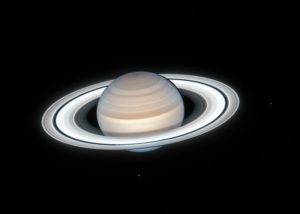Saturn was a god of ancient Rome. According to myth, he was usurped by his son, Jupiter, and wandered across land and sea before founding a new kingdom and giving the local folk — a bizarre menagerie of fauns and nymphs — remarkable new gifts: agriculture, law, civilization. Thus began a golden age of peace, plenty, and bliss. I guess his accomplishments showed that rebellious teenager Jupiter how things are done.
The Roman Empire and Greek city-states are gone, but the star that the Romans named after Saturn is still with us, and easy to see on these cool autumn evenings.
Step outside after dark and look south, a little lower than halfway up the sky. You’ll first notice bright Jupiter (for more on that planet, see my Sept. 23 column). Look to the right of Jupiter and a little lower in the sky. There you’ll see what looks like a dimmer, orange-gold star. That’s Saturn.
Saturn is the second-largest planet of our solar system, about 10 times bigger than Earth. Like Jupiter, the largest planet, Saturn is a gas giant: a planet with a rocky core surrounded by a layer of metallic hydrogen, then a sea of liquid hydrogen and helium, and finally a deep, dense atmosphere of hydrogen and other gases.
In the visible upper layers of Saturn’s atmosphere, astronomers have observed winds of over 1,000 miles per hour, and occasional storms similar to Jupiter’s Great Red Spot. The Great White Spot of 1990 was one of Saturn’s storms that got people’s attention. I think that astronomers could do a better job of naming these massive storms, which are big enough to engulf Earth itself.
Saturn is famous for its rings. You can’t see them with the unaided eye; Saturn looks like any other star in the sky. Early 17th-century observers, including Galileo, noted Saturn’s odd, elongated shape in their telescopes, which were a new invention at the time and yielded only blurred, low-magnification views.

The art and science of optics progressed, and in 1655 Christiaan Huygens was the first to clearly observe the rings for what they were, using a telescope that he had designed himself. Even then the exact nature of the rings remained a mystery until NASA’s Pioneer 11 spacecraft flew by in 1979. Voyager 1 and 2 in the early 1980s provided more details.
The rings are about 70,000 miles wide but only 60 feet thick. They are composed of pieces of ice, somewhat discolored by trace amounts of other material, that range in size from tiny chips the size of the period at the end of this sentence to chunks 30 feet in diameter. Like Earth’s polar ice caps or a snow-covered yard on a winter morning, ice reflects sunlight well, which is why we can see Saturn’s rings, despite how relatively thin they are.
Astronomers have developed several hypotheses to explain the rings’ origin. In one scenario they are the remains of a moon whose orbit decayed due to interactions with other moons, which brought it too close to Saturn; tidal forces — just like the forces that generate our ocean tides — then tore the moon apart, spreading its remains out into the rings we see today.
Other hypotheses propose a comet or asteroid impact that destroyed a moon, or that the rings are left over from Saturn’s formation 4.5 billion years ago. Whatever its beginnings, new evidence from the Cassini spacecraft suggests that the ring system will have an ending as well. It is continually losing material. This beautiful and magnificent structure may be with us for only another 300 million years.
If the night sky allows, Saturn is the first object I show people in my telescope. The rings are distinctly visible, and when it’s especially clear, you can see the separate bands and even the Cassini Division: a narrow 3,000-mile-wide ring of darkness within the set.
Those seeing Saturn for the first time react with some combination of surprise, awe, and joy — some have even wept. I understand the feeling. I encourage you to find someone with a telescope and look at Saturn’s rings with your own eyes. It’s different from seeing a photograph.
Even with the unaided eye, Saturn is a pretty sight. To me its gold color suggests the Golden Age that the Romans, and many other ancient cultures, looked back at with regret and longing, though I like to think that humanity’s best years are yet to come. Clear skies!



